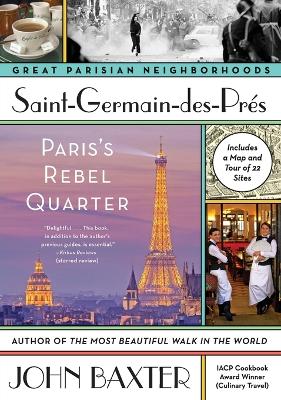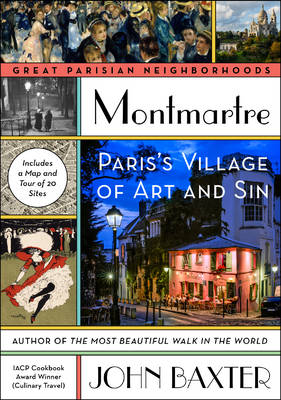Great Parisian Neighborhoods
1 primary work • 3 total works
Book 1
The award-winning chronicler of life in Paris reveals the secrets of his home quarter, Saint-Germain-des-Pres A unique blend of history, memoir, and sightseeing essentials, Saint-Germain-des-Pres is a captivating "narrative guidebook" to one of Paris's iconic quarters by John Baxter, bestselling author of The Most Beautiful Walk in the World. Occupying less than a square mile along Paris's Left Bank, Saint-Germain-des-Pres, originally an independent village centered around the medieval abbey that lends the quarter its name, has for centuries been home to rebels of all stripes. Within its boundaries, the French Revolution was plotted, the guillotine invented, and in 1968 students revolted and clashed with police. Philosopher Descartes is buried here (sans skull), while Sartre, Camus, and de Beauvoir birthed existentialism around the tables of the legendary Cafe de Flore. Saint-Germain sheltered and inspired such artistic rebels as Picasso, Rimbaud, Hemingway, and scores of jazz musicians. Today, the neighborhood, with its cobblestone streets, iconic cafes, and unique shopping destinations, is one of Paris's premier tourist attractions.
And yet it retains its rebel soul-if you know where to look. In this first book in his "Great Parisian Neighborhoods" series, Baxter, an expat who has called Saint-Germain home for more than two decades, guides readers on an off-the-beaten-path journey through the quarter's history, landmarks, and delights.
And yet it retains its rebel soul-if you know where to look. In this first book in his "Great Parisian Neighborhoods" series, Baxter, an expat who has called Saint-Germain home for more than two decades, guides readers on an off-the-beaten-path journey through the quarter's history, landmarks, and delights.
In the third portrait of his series Great Parisian Neighborhoods, award-winning raconteur John Baxter takes readers on a dazzling excursion of Montparnasse. By the IACP Award-winning author of the national bestseller The Most Beautiful Walk in the World, MONTPARNASSE reveals the history and present delights of the iconic neighborhood that is best associated with the vibrant 1920-30s-era Paris-a romantic time and place evoked in Hemingway's memoir A Moveable Feast and Henry Miller's Tropic of Cancer. From the first meeting of Hemingway and F. Scott Fitzgerald to their friendship's bitter conclusion; from the courage of the anti-Nazi resistance to the clubs where German generals partied; from the attempted murder of Samuel Beckett to the rise of Josephine Baker to stardom; from the high life of the Coupole and the Cafe du Dome to the bawdy music halls of rue de la Gaite; no Paris quarter has witnessed more tumultuous events than Montparnasse.
In a ground-breaking reappraisal of this most glamorous of Paris's districts, Baxter looks beyond the nostalgia to the secret history of Montparnasse, a district where desire effaced memory and every taste could be satisfied-even those which were unexpressed. If, as Oscar Wilde suggested, all good Americans went to Paris when they died, it was Montparnasse that brought them back to life.
In a ground-breaking reappraisal of this most glamorous of Paris's districts, Baxter looks beyond the nostalgia to the secret history of Montparnasse, a district where desire effaced memory and every taste could be satisfied-even those which were unexpressed. If, as Oscar Wilde suggested, all good Americans went to Paris when they died, it was Montparnasse that brought them back to life.
In the second portrait of his series Great Parisian Neighborhoods, award-winning raconteur John Baxter leads us on a whirlwind tour of Montmartre, the hill-top village that fired the greatest achievements of modern art while also provoking bloody revolution and the sexual misbehavior that made Paris synonymous with sin High on the northern edge of Paris, Montmartre has always attracted bohemians, political radicals, the searchers for artistic inspiration as well as those hungry for pleasure. In its winding, windmill-shadowed streets, which, only fifty years before, saw the anarchist rising of the Commune, Renoir, Picasso and van Gogh seized a similar freedom to remake painting, while, in the tenderloin of Pigalle, Toulouse-Lautrec drew the cancan dancers of the Moulin Rouge, celebrating a hedonism that titillated the world, In Montmartre, bestselling author and IACP Award winner John Baxter lifts the curtain on a district that visitors to Paris seldom see.
From the tumbledown workshops of the Bateau Lavoir in which Picasso and Braque created Cubism to Clichy's Cabaret of Nothingness where guests dined at coffins under lamps of human bones, the whole of this mysterious enclave is ours to explore. For visitors and armchair travelers alike, Montmartre captures the excitement and scandal of a fascinating quarter that condenses the elusive perfumes, colors and songs of Paris.
From the tumbledown workshops of the Bateau Lavoir in which Picasso and Braque created Cubism to Clichy's Cabaret of Nothingness where guests dined at coffins under lamps of human bones, the whole of this mysterious enclave is ours to explore. For visitors and armchair travelers alike, Montmartre captures the excitement and scandal of a fascinating quarter that condenses the elusive perfumes, colors and songs of Paris.


